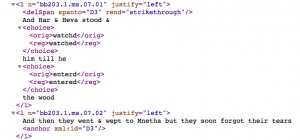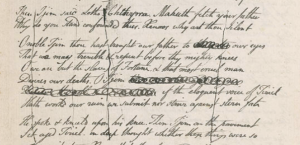There is a batch of Blake’s letters that the Blake Archive is hoping to have ready for publication in the near future. Many are close to being ready and only require proofing. On the other hand, one of those which still requires some work includes sections that look like this:

In fact, that’s how most of the letter looks. There are places in this letter where Blake crossed out part of a line, wrote a new line above the crossed-out line, then crossed out part of the new line, then wrote a new one on top of that one. And that might not even be the most complicated scenario. Since this letter appears to be unfinished, I felt it was necessary for me to gain a firm sense of how the Archive uses tags like <add>, <del>, <subst>, etc. I was advised to look at Tiriel, a recently published manuscript work which provides a good precedent for how we handle all kinds of pertinent situations. What I’ve found is that while nothing in the descriptions of these tags in the “Filling out an XML document” link on the WIP site seems particularly inaccurate or out-dated, it’s a lot easier to understand them if you have examples in front of you. Providing some representative and informative cases from Tiriel here will not make transcribing letters like this one easy, but hopefully a close look at these cases will provide a clearer conception of the basics of how these tags work.


We use <substSpan> any time we have deleted and added text which span more than one line. Because a supralinear insertion always gets its own line, separate from the line into which it is being inserted, this means that even something as simple as a word crossed out with a new word written over it requires us to use <substSpan>.


We use <delSpan> to indicate a situation where more than one line of text is deleted. <substSpan> and <delSpan> both include the element “spanto=” and the end of the deleted text should be indicated with <anchor xml:id=””>. I asked where the value for spanto and anchor id comes from and was told that it might be arbitrary, but the crucial thing is that the value for a spanto is the same as the value for its corresponding anchor.



How do we deal with several lines of text sitting in the margin of the main body? The above example from Tiriel provides several important answers. First of all, use <add type=”insertion” place=”marginright”> (or “marginleft” if it were the left margin obviously). Second, if it’s more than one line, it’s an <addSpan>. It also seems from this example that we count the added line or lines as different lines (with different numbers) even in cases where they seem to be adjacent to lines of the main body of text.
One final thing this example shows us how to handle is a deleted addition; use an <add> element inside of a <delete> element. If only part of an addition is deleted then it’s the other way around; the <del> goes inside of the <add> or the <addSpan>.


One of the biggest takeaways from studying the Tiriel manuscript is that we vastly prefer <del> to <gap/>. In other words, we try very hard to read the text that has been crossed out or scribbled over. I found passages in the manuscript like the one below. I would have been tempted to transcribe it as a <gap/> hence not attempting to read the text underneath the scribble, but apparently this would be the wrong move. I don’t know how the people in charge of this transcription read the text in question, but I’ll have to keep in mind that we push ourselves to uncover it if at all possible.

The opposite situation also warrants comment; A deletion does not necessarily mean that each word is individually crossed out. In the transcription of the text in the image above, every one of these lines is considered deleted. All of the text in every line is encapsulated by <del>. The three vertical lines indicate a deletion even though they don’t actually cover all of the text.
Hopefully having a blog entry with these examples and explanations of what sort of precedent they indicate will prove helpful in the future when working with similarly complicated works.
